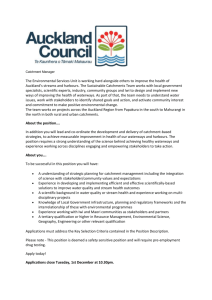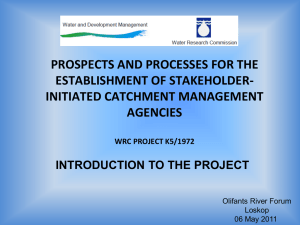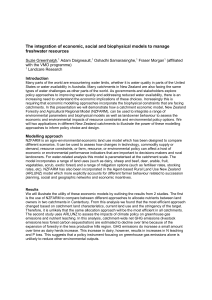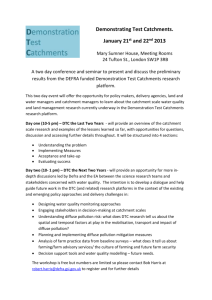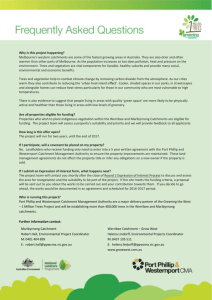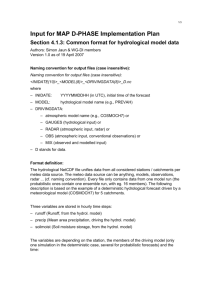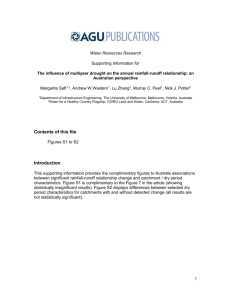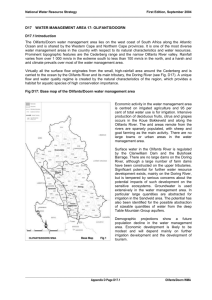InfoFeb04English
advertisement
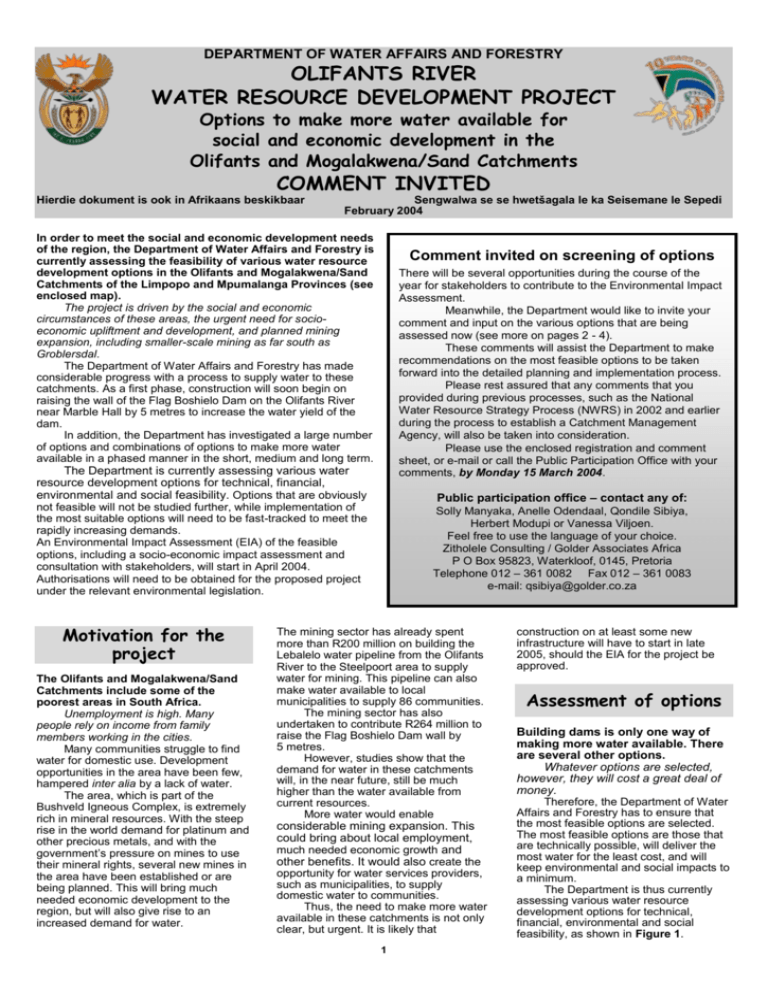
DEPARTMENT OF WATER AFFAIRS AND FORESTRY OLIFANTS RIVER WATER RESOURCE DEVELOPMENT PROJECT Options to make more water available for social and economic development in the Olifants and Mogalakwena/Sand Catchments COMMENT INVITED Hierdie dokument is ook in Afrikaans beskikbaar Sengwalwa se se hwetšagala le ka Seisemane le Sepedi February 2004 In order to meet the social and economic development needs of the region, the Department of Water Affairs and Forestry is currently assessing the feasibility of various water resource development options in the Olifants and Mogalakwena/Sand Catchments of the Limpopo and Mpumalanga Provinces (see enclosed map). The project is driven by the social and economic circumstances of these areas, the urgent need for socioeconomic upliftment and development, and planned mining expansion, including smaller-scale mining as far south as Groblersdal. The Department of Water Affairs and Forestry has made considerable progress with a process to supply water to these catchments. As a first phase, construction will soon begin on raising the wall of the Flag Boshielo Dam on the Olifants River near Marble Hall by 5 metres to increase the water yield of the dam. In addition, the Department has investigated a large number of options and combinations of options to make more water available in a phased manner in the short, medium and long term. Comment invited on screening of options There will be several opportunities during the course of the year for stakeholders to contribute to the Environmental Impact Assessment. Meanwhile, the Department would like to invite your comment and input on the various options that are being assessed now (see more on pages 2 - 4). These comments will assist the Department to make recommendations on the most feasible options to be taken forward into the detailed planning and implementation process. Please rest assured that any comments that you provided during previous processes, such as the National Water Resource Strategy Process (NWRS) in 2002 and earlier during the process to establish a Catchment Management Agency, will also be taken into consideration. Please use the enclosed registration and comment sheet, or e-mail or call the Public Participation Office with your comments, by Monday 15 March 2004. The Department is currently assessing various water resource development options for technical, financial, environmental and social feasibility. Options that are obviously Public participation office – contact any of: not feasible will not be studied further, while implementation of the most suitable options will need to be fast-tracked to meet the rapidly increasing demands. An Environmental Impact Assessment (EIA) of the feasible options, including a socio-economic impact assessment and consultation with stakeholders, will start in April 2004. Authorisations will need to be obtained for the proposed project under the relevant environmental legislation. Motivation for the project The Olifants and Mogalakwena/Sand Catchments include some of the poorest areas in South Africa. Unemployment is high. Many people rely on income from family members working in the cities. Many communities struggle to find water for domestic use. Development opportunities in the area have been few, hampered inter alia by a lack of water. The area, which is part of the Bushveld Igneous Complex, is extremely rich in mineral resources. With the steep rise in the world demand for platinum and other precious metals, and with the government’s pressure on mines to use their mineral rights, several new mines in the area have been established or are being planned. This will bring much needed economic development to the region, but will also give rise to an increased demand for water. Solly Manyaka, Anelle Odendaal, Qondile Sibiya, Herbert Modupi or Vanessa Viljoen. Feel free to use the language of your choice. Zitholele Consulting / Golder Associates Africa P O Box 95823, Waterkloof, 0145, Pretoria Telephone 012 – 361 0082 Fax 012 – 361 0083 e-mail: qsibiya@golder.co.za The mining sector has already spent more than R200 million on building the Lebalelo water pipeline from the Olifants River to the Steelpoort area to supply water for mining. This pipeline can also make water available to local municipalities to supply 86 communities. The mining sector has also undertaken to contribute R264 million to raise the Flag Boshielo Dam wall by 5 metres. However, studies show that the demand for water in these catchments will, in the near future, still be much higher than the water available from current resources. More water would enable considerable mining expansion. This could bring about local employment, much needed economic growth and other benefits. It would also create the opportunity for water services providers, such as municipalities, to supply domestic water to communities. Thus, the need to make more water available in these catchments is not only clear, but urgent. It is likely that 1 construction on at least some new infrastructure will have to start in late 2005, should the EIA for the project be approved. Assessment of options Building dams is only one way of making more water available. There are several other options. Whatever options are selected, however, they will cost a great deal of money. Therefore, the Department of Water Affairs and Forestry has to ensure that the most feasible options are selected. The most feasible options are those that are technically possible, will deliver the most water for the least cost, and will keep environmental and social impacts to a minimum. The Department is thus currently assessing various water resource development options for technical, financial, environmental and social feasibility, as shown in Figure 1. Technical feasibility These assessments investigate engineering solutions and technologies to make more water available. For example, would there be sufficient groundwater to supply some areas? Can water be used more efficiently? Are there suitable sites to store water in dams? Is it possible to transfer more water from elsewhere into these catchments? Financial feasibility These studies consider the capital and operating costs of infrastructure such as dams, pipelines, water transfer schemes, groundwater pumping, the costs of mitigation measures to pro-actively protect the environment. ASSESSMENT OF OPTIONS TECHNICAL FINANCIAL ENVIRONMENTAL/ SOCIAL Figure 1. All water resource development options are being assessed for technical, financial, environmental and social feasibility. Environmental and social feasibility The National Water Act, the Environment Conservation Act and the National Environmental Management Act require an EIA to show whether any options that remain after screening will be environmentally and socially feasible. The findings of the EIA will also inform the technical and financial studies. Specific socio-economic studies will be done on the options that are taken forward. Other studies will cover potential impacts to surface water supply to the downstream Kruger Park and Massingir Dam in Mozambique. Potential impacts to water quality, land, soil, fauna and flora and specifically to the Reserve (the amount of water set aside in the National Water Act for basic human needs and ecological needs) will also be studied. Since the project is led by a national government Department (Water Affairs and Forestry), spans two provinces, and is deemed to be in the national interest, the national Department of Environmental Affairs and Tourism will be the decision-making authority on the EIA. The EIA will start in April 2004. There will be several further opportunities for stakeholders to contribute to the EIA during the coming year. MAKING MORE WATER AVAILABLE – WHAT OPTIONS ARE THERE? Approach to options analysis Options available for the Olifants Catchment Considerable planning to screen options out and to find the most feasible options has already been done. Planning makes use of the findings of numerous previous studies and current work. For example, stakeholders will recall the figures that were presented during the public consultation meetings for the proposed National Water Resource Strategy (NWRS) in 2002. These figures showed a clear water deficit, and these are currently being firmed up. Planning for the project follows a five-step approach: The Olifants Catchment and the project area are indicated on the enclosed map. The catchment falls within Water Management Area (WMA) 4 of the 19 WMAs into which the country is divided. The largest water users in this area are irrigation agriculture, the mines and domestic users. 1. Identifying water requirements Studies are already determining how much water people and developments in the catchments need both now and in the future. This includes the needs of domestic users, agriculture, mining and industry, and others. Irrigation is currently the single largest user, but water supply from the new developments are likely to be too expensive for use by irrigators. Although groundwater is available in some areas, its natural quality is not always good enough for domestic use. For example, high nitrate levels occur in boreholes north of Steelpoort. Such groundwater can be used by mines but not directly for domestic water supply. 2. Identifying available resources The studies will determine how much water is available in these catchments now, and from what sources. 3. Comparing requirements with availability (water balance) The studies will compare the available water with how much water is, and will be, needed in the future. 4. Identifying and assessing options Options include water conservation and demand management, possible dam and pipeline developments, availability of groundwater, reallocation of water from other uses, reuse, and transfer of water from other catchments. The costs and benefits of the different options and combinations of options are also being determined. 5. Recommending feasible options Lastly, once the above information is available, a combination of the most feasible options for each of the Olifants and Mogalakwena/Sand catchments will be taken forward into the detailed planning and implementation process. A list of questions to help guide your comment is provided on the enclosed comment sheet. 2 Available resources The available volume of surface water in rivers and in the Flag Boshielo Dam, and the volume of groundwater, are being investigated. Development options The wall of the Flag Boshielo Dam will be raised by 5 metres, and construction will start soon. This will enable water entitlements, currently leased by the Lebalelo Water User Association in the Steelpoort area for mining ventures, to be returned to small farmers on the irrigation schemes downstream of the Flag Boshielo Dam. The following additional options and their costs and benefits are being investigated: A possible new dam at Rooipoort on the Olifants River A possible new dam at De Hoop on the Steelpoort River Groundwater supply. The best option will be chosen after an assessment of the options. Water transfers South Africa has the largest number of water transfer schemes in the world. Water is transferred from areas of surplus to areas of scarcity. Water is already being transferred out of the Olifants catchment to the city of Polokwane, which is located in the Sand catchment. However, water is already being transferred from the Komati, Usutu and Vaal Rivers into the southern parts of the Olifants catchment. Water transfer schemes are very expensive. Nevertheless, investigations are underway to investigate further water transfers from the Vaal River System to the Witbank and Middelburg areas. These transfers could possibly be extended into parts of the project area. Other options Another option to make more water available is to use water trading to reallocate water from other uses. Although the National Water Act provides for this, stakeholders are concerned that potential social and economic impacts may not make this option feasible unless very carefully managed. Re-use of effluent from Lebowakgomo is another possibility. This would require the effluent to be treated and piped to areas where the water is needed. This option is technically feasible and, although expensive compared with the volume of water it can make available, the water would be suitable for mining that does not require high quality standards. Many water users in these catchments have suggested water conservation and demand management as an option, saying that money should not be spent on new infrastructure if existing water users could use water more efficiently. Initial calculations show that water can be used more efficiently in the catchment. Although the additional water that will become available in this way will be small as compared with what will be needed in the future, it could make an important contribution. Bulk distribution systems As part of the project, bulk water supply pipelines for both raw and potable water will be built in areas that are currently poorly serviced and where growth in water needs are expected. The capacity and condition of existing bulk distribution systems, and the size of planned and new bulk distribution systems, will be determined and matched to the potential options for dam or groundwater development, along with potential for access to land and obtaining servitudes. It is interesting to note that the largest proportion of the costs of the project would be for the bulk distribution systems, due to the large area that has to be covered. OPTIONS AVAILABLE FOR THE MOGALAKWENA / SAND CATCHMENT The Mogalakwena and Sand Catchments are indicated on the enclosed map. They fall within Water Management Area (WMA) 1 of the 19 WMAs into which the country is divided. The largest water users in this area are again irrigation agriculture, the mines and domestic users. Available resources There are few surface water resources in this area, as there are no large rivers and only the Doorndraai Dam, whose water is already fully allocated to existing users. However, groundwater is available in parts of these catchments. Stakeholders have suggested that serious consideration be given to further development of groundwater resources, especially for local communities. Development options A number of development options are available to these catchments. Apart from groundwater, the possibility of dams on the Lephalala River and at Groenvlei have been investigated in the past. Although these investigations were not very promising at the time, they are being re-investigated now. Water transfers As mentioned before, water is already being transferred to Polokwane in the Sand catchment from the Olifants Catchment and also from the Letaba Catchment. Should any of the dam options in the Olifants catchment be feasible, it may be possible to transfer further water from the Olifants to the Mogalakwena/Sand catchments. Internal water transfers within these catchments are also options, for example, from the Doorndraai Dam (although this would mean having to find other water for existing users of water from this dam). In addition, effluent from Polokwane could be re-used by mining near Makopane. Should a dam at Lephalala be found to be feasible, a further option would be to transfer water from this dam to areas where water is needed. This, however, would require further extensive investigation. 3 Other options As with options for the Olifants Catchment, there is an option to reallocate water from other uses through water trading. This would mean that existing water users would be able to “sell” their water entitlements to other users. Stakeholders have indicated that this is not as simple a solution as it seems. What, for example, will happen to farm workers if farmers sell their water to other users? The re-use of effluent is also being investigated for this area, looking at how much effluent is available and from where. Re-using effluent means, however, that less water finds its way back to the rivers or groundwater. The impacts of this need to be carefully determined before this option can be selected. On the other hand, re-using effluent not only solves potential water quality problems but also puts the water to high-value use. Users in these catchments have again suggested water conservation and demand management as an option. The study team is currently calculating how much water could be saved in this way, and the contribution this would make to the water needs of other users. Meeting the requirements of the Reserve In accordance with the National Water Act, the Reserve is that portion of water required to meet basic human needs, and the needs of the aquatic ecosystem. The requirements of the Reserve are being worked out for all potential options in all areas. Compulsory licensing, particularly to meet the requirements of the Reserve, will also be considered, along with the practicalities of implementing it. Compulsory licensing involves a process of determining how much water the Reserve requires, and then reducing existing water allocations to meet the needs of the Reserve. CREATING AN ENABLING ENVIRONMENT FOR THE PROJECT Regional economics A project of this nature requires considerable planning and integration of the findings of studies. It also requires ongoing liaison with stakeholders, cooperative governance to involve the full range of government departments, international liaison with South Africa’s neighbouring States, and putting in place the institutions that will have to manage the project during its construction, commissioning and operation. A regional economic assessment will start shortly to quantify the potential economic impacts of the project on a regional scale. The assessment will consider, for example, household income, development opportunities, employment creation and other economic spin-offs. Financing and ownership Institutional arrangements The options to fund, implement and operate the project are also being investigated. Funds could come from a variety of sources, potentially including the private sector. Whatever the sources of funding, the project is considered to be national water resource infrastructure that will serve different users in different catchments. Ownership will therefore remain with the State. The best institutional arrangements to manage the project, or to manage components of it, need to be determined. Again, various models are available. A high-level Project Strategy Committee between the Department of Water Affairs and Forestry and the Limpopo and Mpumalanga Provincial Governments has already been established to steer project implementation. Institutions to help run the project during its operation could include, for example, Water Boards or Water User Associations. Such bodies could be responsible for the operation of different schemes. In addition, water resource management is another required function. The National Water Act provides for Catchment Management Agencies (CMA) to be established in each Water Management Area (WMA) to fulfil the water resource management function. A proposal for CMA establishment in the Olifants WMA has been drafted with stakeholder participation. Until a CMA is established, the Department remains responsible for water resource management in that WMA. All these and other possible options are currently being investigated, and stakeholder comment on these is being sought. Capacity for community water supply Although this project will not be directly responsible for community water supply, it will make water for community water supply available to local water services providers, such as municipalities. For this purpose, off-takes will be provided from the bulk distribution system or water will be delivered into reservoirs at agreed locations. Environmental and other authorisations Before a project such as this can be implemented, a range of environmental and other authorisations need to be obtained, and the necessary studies done to determine the potential negative and positive impacts. These studies will also recommend ways to enhance positive impacts, and to reduce or avoid negative impacts. For these reasons, an Environmental Impact Assessment and other investigations will start in April 2004, with full stakeholder consultation, to satisfy the requirements of relevant legislation. Honouring international agreements The Olifants River is part of the international Limpopo River System shared by South Africa, Botswana, Zimbabwe and Mozambique. South Africa is currently formally consulting with its neighbours about the proposed project. Stakeholder engagement Cooperative governance Many consultation processes on water resource development and management have taken place in the project area in the past. In many parts of the catchments, stakeholders have established consultation structures, development associations, water forums and associations, and have contributed substantially to current planning. Consultation with stakeholders will continue throughout project planning, and in particular from April 2004 when the Environmental Impact Assessment for the water resource development options will start. At the same time, consultation will take place around the various other authorisations that need to be obtained in terms of relevant legislation. Making additional water available in the Olifants and Mogalakwena / Sand catchments is likely to give rise to many development opportunities, changes in socio-economic circumstances, changes in land use and other effects. Numerous other government authorities thus need to be consulted and involved, in order to accommodate these developments in their future planning and activities. This includes the local authorities in their integrated development plans (IDPs). Together with the Department of Water Affairs and Forestry, they will assist in ensuring that, in the longer term, all the projects and developments coming out of this initiative are sustainable, and that as many people as possible benefit from the work that is done and the investigations that are made. Your participation in this project is encouraged, and will enrich decision-making. Please provide your initial comments by Monday 15 March 2004. Note also that, as more information becomes available, it will be posted on the Department’s Web Site: www.dwaf.gov.za 4

